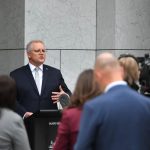Australian Multiculturalism – cherish it, build on it
Australia was originally successful in developing an acceptable way of integrating immigrants from non-English speaking backgrounds. Klaas Woldring wonders why today our political and electoral system doesn’t reflect the composition and values of our society.
Those who have viewed and digested the 2012 SBS documentaries “Go back to where you came from” may well have asked themselves: how embedded are the multicultural values in Australian society really?
One could add that the escalation of the quite shameful asylum seeker policies of both major parties raise that question again, even more so perhaps. And this is not just a question that could be put to the majority Anglo-Australian segment of the population. Some WWII migrants of non-English speaking countries display similar reservations and fears. Reports about the problems with multiculturalism in France and other European countries fuel negative sentiments in Australia as well. Visitors like the Dutch MP Geert Wilders warn in alarmist fashion of “an Islamic take-over of the Western World”. Why should our major political parties pander to such misguided minority views?
The objectives of multiculturalism in Australia have a quite different origin as compared to the European countries. In Australia it developed as a far more acceptable and successful way to integrate immigrants from non-English speaking backgrounds than “assimilation”. In European countries, none of them really immigrant countries, the majority of guest workers and refugees originate from former colonies often with struggling economies or civil strife. This is a huge difference. There can be little doubt about the truly remarkable successes of multiculturalism in Australia in terms of its objectives. It has contributed vastly to Australia’s economic progress and cohesive social diversity. It has significantly enriched the Australian culture. However, my own view is that, while this is a solid base to build on, it hasn’t gone far enough.
My purpose here is to highlight the continued under-representation of ethnic communities at elite levels of the society. There are various reasons for this but it should be noted that it has resulted in a lack of recognition and underutilisation of talent. This has been noted by several other observers.
Here is a 1989 statement from the National Agenda for a Multicultural Australia:
“The cultural diversity of Australia is not reflected in the key decision-making institutions of society. This is particularly true of our formal political structures. The representation of women, Aboriginal people and people from non-English speaking backgrounds is poor at all levels of the Australian political system. Elected representation at the municipal, State and Federal levels of government does not mirror the ethnic composition of the total population. At the State and Commonwealth levels, for example, only 7% of Parliamentarians are from non-English speaking backgrounds” James Jupp (1989).
Seventeen years later, a very comprehensive and detailed paper published by the NSW Parliamentary Research Library, reaches the following conclusion:
“The purpose of this paper has been to highlight some of the complex historical, theoretical and structural aspects hindering the capacity of parliaments to reflect the cultural diversity of the Australian community. At present, ethnic and racial minorities remain disproportionately under-represented in legislatures around Australia. The debate surrounding the appropriate level of presence of ethnic and racial minorities in legislative chambers revolves around questions of democracy, equality and recognition. It gives rise to the threshold question of which groups deserve representation, and how are these groups to be defined?” Karina Anthony (2006)
The major problem here is the single-member electoral district system that favours mostly male traditional “Aussie” candidates, not NESB minority candidates unless they are representing a very strong minority in an electoral district. Proportional Representation (Open Party List System) would remove this bias and has many other advantages as well.
There certainly are also other barriers such as the paucity of multicultural programs on the ABC. This has largely been the result of the sensible creation of SBS, but does it mean that the ABC should therefore limit multicultural programs?
The Award systems for citizens’ achievements, e.g. the Imperial Honours system, Australian OA system, Australian Citizens of the Year seem to favour Anglo-Australians over others. Is this deliberate discrimination? I doubt it. More likely it has to do with the composition of selection committees, old boy and old girl networks. That may well be true also of executive selection systems in all large organisations, public services, the judiciary, prisons, universities, large corporations, and the media as well.
Extensive research by NATSEM and the AMP (November, 2010) confirms the lack of NESB representation on corporate boards.
In a Business Review Weekly issue (2011) an article appeared under the title “Bamboo Ceiling“. Its introduction reads “Corporate Australia, especially its senior roles and boards, remains staunchly Anglo-Celtic, despite the changed make-up of our society and a growing number of people from Asia.”
The article dwells on the enormous changes in the make-up of the population since 1947 to the present day, describing Australia as “an astonishing transformation from monocultural outpost to multicultural beacon”. Concentrating on Asian-born Australians (especially Chinese and Indians) it is forecast that the group will overtake European-born migrants within three years. “Why do these groups not have more visible profile in the leadership and governance of companies“, asked Nareen Young, CEO of the Diversity Council Australia. The Council believes that it’s time cultural diversity “was given the same prominence as the push for gender diversity”.
The description “multicultural beacon” is the one to build on. Some of the migrants and refugees of the past have become the shining lights of the present. They thrive in the multicultural environment of the new country. Why tell newcomers “you won’t be settled here”, send them to PNG, Manus Island and Nauru wasting their lives there while they are keen to contribute to a multicultural Australia? Get them here, the sooner the better. They are energetic, highly motivated and willing to learn. Our real problem is: Why is it that our political and electoral systems throw up politicians who do not reflect the composition and values of our society?
References:
Anthony, K, (2006) – The Political Representation of Ethnic and Racial Minorities, NSW Parliamentary Library Research Paper 30.
Fisher, Leo D’Angelo (2011) – Bamboo Ceiling – Corporate Australia remains Anglo Celtic. Business Review Weekly, September 15 – 20, 2011
Jupp, J. (1989) – The Political Participation of Ethnic Minorities in Australia, in
Jupp, J. York, B. & Mcrobbie, A. – The Political Participation of Ethnic Minorities in Australia, AGPS, Canberra, 1989
NATSEM (2010) – Calling Australia Home – The Characteristics and Contributions of Australian Migrants, a report written by Riyana Miranti, Nino Nepal and Justine McNamara from NATSEM
for the AMP – Income and Wealth Report, 27 November, 2010.
Woldring, K. (1996) – The Concrete Ceiling – A Sympathetic View of a Waste of Talent, Policy Organisation and Society, No. 11, Summer issue.
Woldring, K. (1996) – Diversity Management – Utility, Equity or Both? Conference paper ANZAM, 10th Annual Conference, Wollongong
Woldring, K. (2011) – Education for social inclusion includes participation in decision-making at the highest levels, UWS Conference paper
Dr. Klaas Woldring is a former Associate Professor at Southern Cross University and the co-founder of Beyond Federation, a citizen group which campaigns to abolish the states and strengthen local government. His latest book is Yes, We Can… … Rewrite the Australian Constitution.














